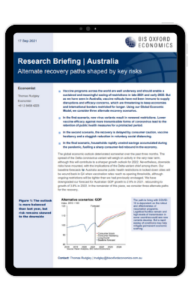Australia | Alternate recovery paths shaped by key risks

Vaccine programs across the world are well underway and should enable a sustained and meaningful easing of restrictions in late-2021 and early-2022. But as we have seen in Australia, vaccine rollouts have not been immune to supply disruptions and efficacy concerns, which are threatening to keep economies and international borders restricted for longer. Using our Global Economic Model, we consider three alternate recovery scenarios.
What you will learn:
- In the first scenario, new virus variants result in renewed restrictions. Lower vaccine efficacy against more transmissible forms of coronavirus lead to the retention of public health measures for a protracted period.
- In the second scenario, the recovery is delayed by consumer caution, vaccine hesitancy and a sluggish reduction in voluntary social distancing.
- In the final scenario, households rapidly unwind savings accumulated during the pandemic, fuelling a sharp consumer-led rebound in the economy.
Tags:
Related Services

Post
The euro and depreciation – shake, shake it off
Our new forecast assumes a slower euro appreciation against the dollar over the coming years than we previously anticipated. Relative productivity, terms of trade, and the current account will likely be less supportive of the euro than we thought. In addition, a stronger stock market than initially envisaged will attract more financial flows into the US than we had expected.
Find Out More
Post
Food prices to bottom out in 2024, risks skewed to upside
Our baseline forecast is for world food commodity prices to register an annual decline this year, in aggregate, reducing pressure on food retail prices further downstream. However, we believe the risks to this forecast are overwhelmingly skewed to the upside.
Find Out More